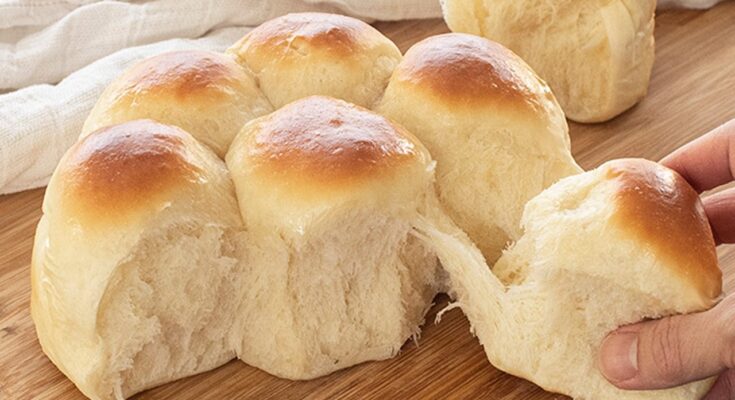Japanese Milk Bread Recipe: Imagine biting into a cloud — that’s pretty much the magic of Japanese Milk Bread. This soft, airy, and slightly sweet bread has stolen hearts across the globe. Unlike regular bread, it stays fresher longer and has a pillow-like texture that feels like a dream. Whether you want it as toast, sandwich bread, or just plain, it never disappoints. Today, I’m walking you through how to make this beauty right at home. Ready? Let’s dive in!
What is Japanese Milk Bread?
Japanese Milk Bread, also called “Shokupan” (食パン) in Japan, is a type of bread that uses a special technique called Tangzhong to create its signature softness. Originating in Japan in the early 20th century, it’s a staple in Japanese bakeries and households.
What makes it different from Western bread? It’s all about the texture and moisture. While your usual loaf might dry out after a day or two, Japanese Milk Bread stays soft and tender for days, thanks to the Tangzhong method. The bread is light, slightly sweet, and oh-so-fluffy — almost like eating a soft pillow.
If you love bread but hate when it gets tough and dry, Japanese Milk Bread might just become your new best friend.
Ingredients Needed for Japanese Milk Bread
You don’t need anything too fancy to make this heavenly bread at home. Here’s what you’ll need:
For the Tangzhong:
- 3 tablespoons bread flour
- ½ cup water
- ½ cup milk
For the Dough:
- 2½ cups bread flour
- ¼ cup sugar
- 2 teaspoons instant yeast
- 1 teaspoon salt
- ½ cup milk
- 1 large egg
- 4 tablespoons unsalted butter, softened
Each ingredient plays an important role. Bread flour gives structure and strength, sugar adds a gentle sweetness, and butter enriches the dough with flavor and softness. And, of course, milk and egg make it super tender and delicious.
Special Ingredient: Tangzhong (Water Roux)
Here’s where the magic happens: Tangzhong.
Tangzhong is a cooked mixture of flour and liquid (usually water or milk), heated until it becomes a thick paste. It might sound complicated, but trust me, it’s super easy — and it makes a world of difference.
When you add Tangzhong to your dough, it holds more moisture, which keeps the bread softer and fresher for longer. Plus, it helps the dough rise higher, making the bread extra fluffy.
Without Tangzhong, Japanese Milk Bread just wouldn’t be the same. So, don’t skip it!
Step-by-Step Guide to Make Japanese Milk Bread
Alright, let’s roll up our sleeves and get baking!
Step 1: Preparing the Tangzhong
- In a small saucepan, combine 3 tablespoons of bread flour, ½ cup of milk, and ½ cup of water.
- Whisk them together until smooth.
- Cook over medium heat, stirring constantly, until the mixture thickens into a pudding-like consistency.
- Remove from heat and let it cool to room temperature.
Tangzhong is ready! Time to move on.
Step 2: Mixing the Dough
- In a large mixing bowl, combine 2½ cups bread flour, ¼ cup sugar, 2 teaspoons instant yeast, and 1 teaspoon salt.
- Add the cooled Tangzhong, ½ cup milk, and 1 large egg.
- Mix everything together until a sticky dough forms.
- Knead by hand or using a stand mixer for about 10 minutes.
- Add the softened butter and continue kneading until the dough is smooth and elastic (another 10 minutes).
You know it’s ready when you can stretch a piece of dough thin enough to see light through it — this is called the “windowpane test.”
Step 3: First Proofing
- Shape the dough into a ball and place it in a greased bowl.
- Cover with plastic wrap or a damp towel.
- Let it rise in a warm place until it doubles in size (about 1 to 2 hours).
Patience pays off here!
Step 4: Shaping the Dough
- Once doubled, punch down the dough gently to release the gas.
- Divide it into three equal pieces.
- Roll each piece into a ball, then flatten and roll it up like a cinnamon roll.
- Place the rolled pieces seam side down in a greased loaf pan.
It already looks promising, right?
Step 5: Final Proofing
- Cover the pan loosely and let the dough rise again until it’s puffy and nearly doubled (about 45 minutes to 1 hour).
This second proofing gives the bread its final airy structure.
Step 6: Baking
- Preheat your oven to 350°F (175°C).
- Brush the top of the dough with milk or egg wash for a glossy finish.
- Bake for 25 to 30 minutes, or until the top is golden brown and the loaf sounds hollow when tapped.
And there you have it — fresh, homemade Japanese Milk Bread!
Tips for the Best Japanese Milk Bread
Making Japanese Milk Bread isn’t difficult, but a few smart tips can make a big difference:
- Don’t rush the kneading: Kneading develops the gluten structure, which is crucial for the fluffy texture. Be patient and check for the windowpane effect.
- Use room-temperature ingredients: Cold milk or eggs can slow down the yeast activity. Let your ingredients sit out a bit before you start.
- Proof properly: Under-proofed dough won’t rise enough, while over-proofed dough can collapse. Look for the dough to double in size, not more, not less.
- Weigh your ingredients: Measuring by weight instead of cups ensures consistency, especially for baking where precision matters.
- Adjust for humidity: If it’s very humid, your dough might need a little more flour; if it’s dry, a bit more liquid. Trust your hands over strict measurements.
By following these tips, you’ll end up with a loaf so light and fluffy, it’ll make you feel like a master baker.
Serving Suggestions
Japanese Milk Bread is crazy versatile. Here’s how you can enjoy it:
- Classic Toast: Just slice it, toast it lightly, and slather it with butter and jam.
- Sandwich Bread: Its sturdy-yet-soft texture makes it perfect for all kinds of sandwiches, from simple ham and cheese to elaborate egg salad.
- French Toast: Soak thick slices in a rich custard mix and pan-fry to golden perfection. The pillowy texture soaks up flavors beautifully.
- Bread Pudding: Cube it up and bake it into a decadent dessert with cream, sugar, and your favorite mix-ins like chocolate chips or berries.
- Japanese “Fruit Sando”: Make a delicate dessert sandwich with whipped cream and fresh fruits like strawberries, kiwi, and mango.
Trust me, once you try it, you’ll find endless ways to make this bread the star of your meals!
Storage and Freshness
You’ll want to savor every slice of your homemade bread, and proper storage is key:
- Room Temperature: Store the bread in a plastic bag or airtight container for up to 4 days. Keep it in a cool, dry place away from direct sunlight.
- Freezing: For longer storage, slice the bread and wrap the slices individually in plastic wrap. Place them in a freezer-safe bag. They can last up to 2 months in the freezer.
- Reheating: When you’re ready to eat, you can thaw slices at room temperature or pop them straight into the toaster.
Unlike store-bought bread that turns stale quickly, Japanese Milk Bread holds its soft texture much longer. But let’s be real — it’s so delicious, it probably won’t last that long anyway!
FAQs about Japanese Milk Bread Recipe
What makes Japanese milk bread different from regular bread?
Japanese milk bread, also known as Shokupan, is softer, fluffier, and slightly sweeter than regular bread. The secret lies in the use of the Tangzhong method, where a cooked flour-water paste is added to the dough to create its signature light texture.
What is Tangzhong, and why is it important?
Tangzhong is a simple mixture of flour and water (or milk) heated together to form a thick paste. Adding Tangzhong to the dough helps retain moisture, making the bread incredibly soft and keeping it fresh for longer.
Can I make Japanese milk bread without a stand mixer?
Yes, you can! While a stand mixer makes kneading easier, you can also knead the dough by hand. It will take a bit longer (about 15-20 minutes), but with patience, you’ll achieve the same silky, stretchy dough.
Why is my milk bread not fluffy?
If your bread isn’t fluffy, it might be due to under-kneading, over-proofing, or incorrect measurements. Be sure to knead until the dough is smooth and elastic, and follow proofing times carefully.
Can I use all-purpose flour instead of bread flour?
You can substitute with all-purpose flour, but bread flour is preferred for the best chewy and fluffy texture because of its higher protein content. If using all-purpose flour, expect a slightly softer and less bouncy result.
How long does Japanese milk bread stay fresh?
When stored properly in an airtight container or wrapped tightly, Japanese milk bread can stay fresh for up to 4-5 days. You can also freeze it for longer storage.
Can I add flavors or fillings to Japanese milk bread?
Absolutely! Popular additions include sweet red bean paste, custard, chocolate chips, or even savory fillings like ham and cheese. Just make sure fillings are not too wet to maintain the bread’s soft structure.
Is Japanese milk bread healthy?
Japanese milk bread is richer than basic white bread due to its higher fat and sugar content. While it’s perfectly fine as an occasional treat, it’s best enjoyed as part of a balanced diet.
Can I double the recipe to make more loaves?
Yes, you can easily double the recipe. Just make sure to adjust your bowl and baking pan sizes accordingly, and monitor proofing times, as larger dough quantities might take a little longer to rise.
Conclusion
And there you have it — your full guide to mastering Japanese Milk Bread at home! Making this bread may take a little more effort than tossing together a basic loaf, but believe me, it’s worth every minute. With its feather-light texture, subtle sweetness, and unbeatable freshness, Japanese Milk Bread isn’t just a recipe — it’s an experience.
Don’t be intimidated. Follow the steps, trust the process, and soon you’ll be pulling a golden, fluffy loaf from your oven that smells like heaven itself. Bake it once, and you’ll want to bake it again and again.
Happy baking!



